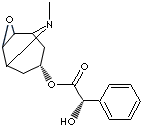SCOPOLAMINE HYDROBROMIDE TRIHYDRATE
PRODUCT IDENTIFICATION

H.S. CODE
SOURCE
CLASSIFICATION
PHYSICAL AND CHEMICAL PROPERTIES
195 - 199 C
AUTOIGNITION
NFPA RATINGS
REFRACTIVE INDEX
Stable under ordinary conditions.
EXTERNAL LINKS & GENERAL DESCRIPTION
Scopolamine: alkaloid drug obtained from plants of the nightshade family (Solanaceae), chiefly from henbane, Hyoscyamus niger. Structurally similar to the nerve substance acetylcholine, scopolamine acts by interfering with the transmission of nerve impulses by acetylcholine in the parasympathetic nervous system and produces symptoms typical of parasympathetic system depression: dilated pupils, rapid heartbeat, and dry skin, mouth, and respiratory passages. Because scopolamine depresses the central nervous system, it is used as a sedative prior to anesthesia and as an antispasmodic in certain disorders characterized by restlessness and agitation, e.g., delirium tremens, psychosis, mania, and Parkinsonism. When combined with morphine, the effect produced is a tranquilized state known as twilight sleep; this combination of drugs was formerly used in obstetrics but is now considered too dangerous. Overdosage of scopolamine causes delirium, delusions, paralysis, and stupor. The alkaloid is found in a variety of nonprescription sedatives. (source: http://www.infoplease.com/)
Two classes of drugs are known to be effective against motion sickness: those that are central cholinergic blockers and those that enhance dopamine-norepinephrine activity. Cholinergic blockers include scopolamine, atropine, dimenhydrinate, cyclizine, meclizine, and promethazine. The effective sympathomimetics include d-amphetamine, methamphetamine, premoline, phenmetrazine, phenemine, and methylphanidate. Scopolamine is the single most effective antimotion sickness drug, consistently providing more protection than any other single medication in clinical trials. It is particularly useful for intense motion or for patients who are very susceptible to motion sickness remedy. Scopolamine is a belladonna alkaloid that acts like atropine. Like the other anticholinergics, this drug acts on the muscarinic receptors, and in this case, blocks all five subtypes. It is also effective in humans at a dosage that does not produce sedation, indicating that its actions may be specific within the vestibular nuclei. The mechanism of action is thought to be associated with inhibition of vestibular input into the CNS which thus inhibits the vomiting reflex. It may also directly act on the vomiting center in the reticular formation of the brainstem. Scopolamine has been shown to be effective in all the classic cases of motion sickness, involving car, air, train, and sea travel, as well as exposure to virtual reality systems.(25) It is currently available for prescription in two forms: a transdermal patch and a low dose tablet. Each dosage form has its respective benefits and disadvantages which warrant consideration when evaluating the needs of any particular patient. The scopolamine patch, (Transderm Scop, Novartis Pharmaceuticals) is attached to the skin behind the ear in a hairless area and delivers 0.5 mg of scopolamine at a fairly consistent rate over 3 days. This makes the patch useful for long exposures to motion sickness, such as a prolonged sea voyage since the patient need not remember to take the shorter-acting tablets. (source: http://www.motionsickness.net/)Pharmacological actions
- Anaesthesia
- Adjuvant
- Autonomic agent
- Central nervous system agent
- Cholinergic antagonist
- Muscarinic antagonist
- Mydriatic
- Neurotransmitter agent
- Parasympatholytic
- Peripheral nervous system agent
APPEARANCE
IDENTIFICATION
pass
ASSAY
pH
OPTICAL ROTATION
-24° -26° C
LOSS ON DRYING
10.0% - 13.0%
RESIDUE ON IGNITION
0.1% max